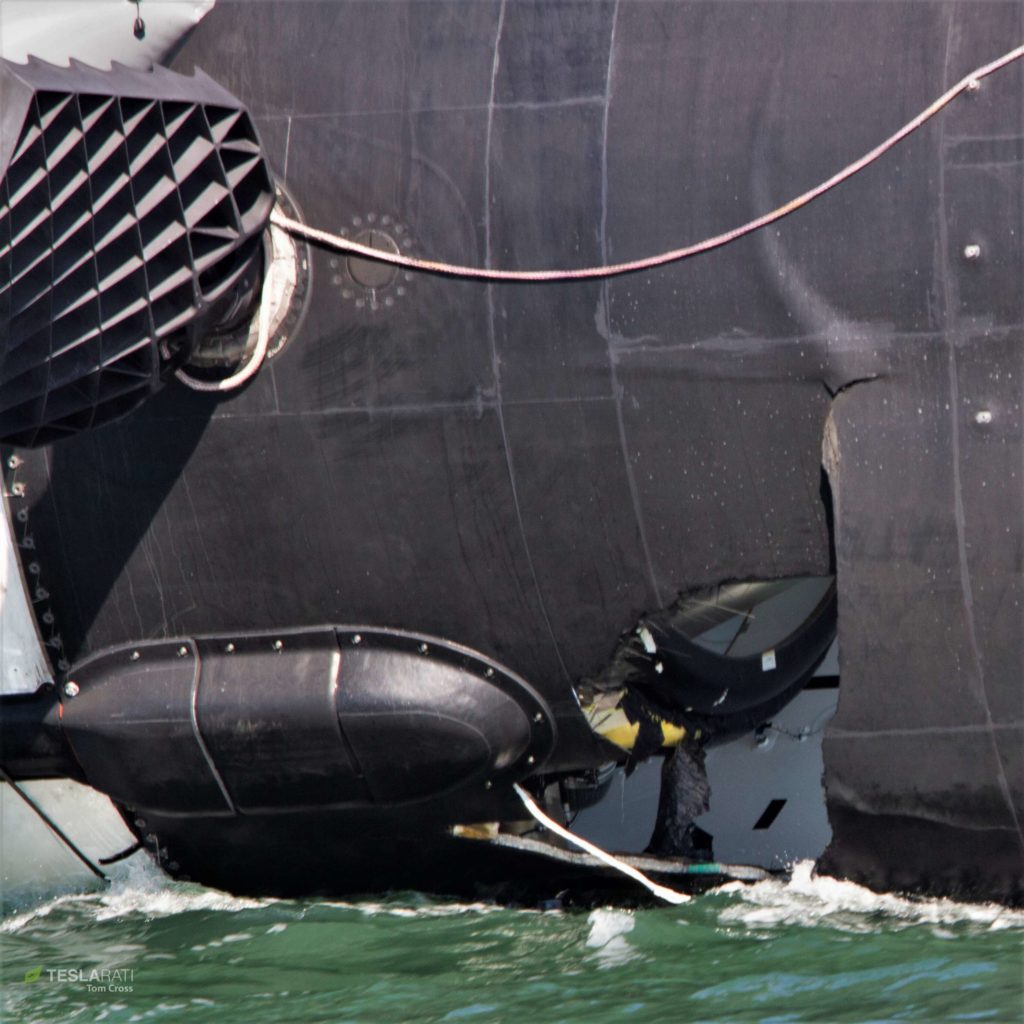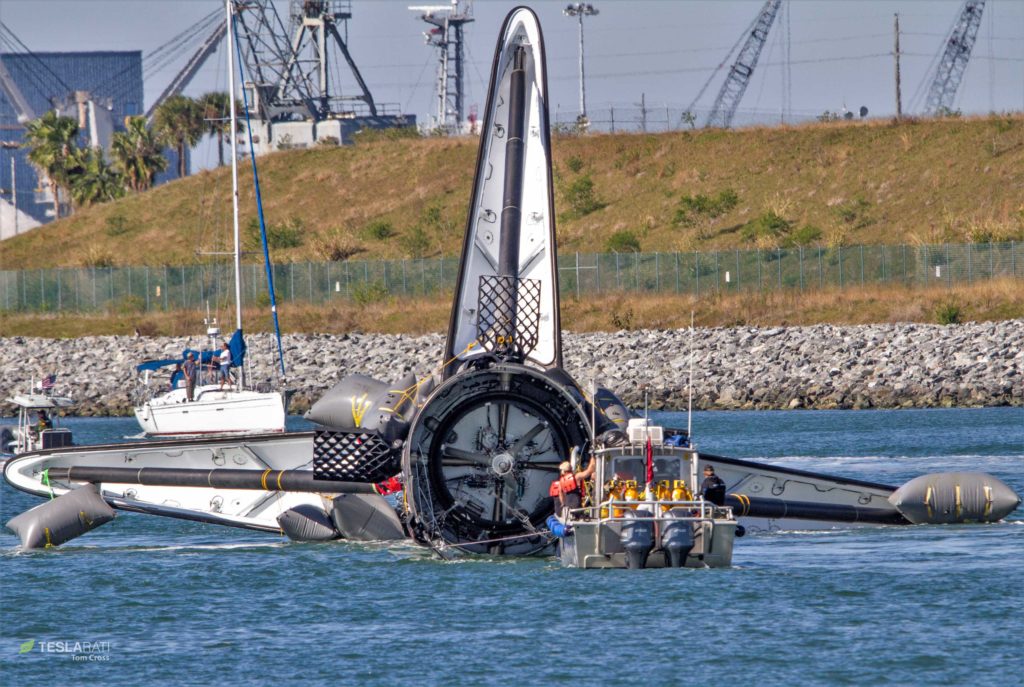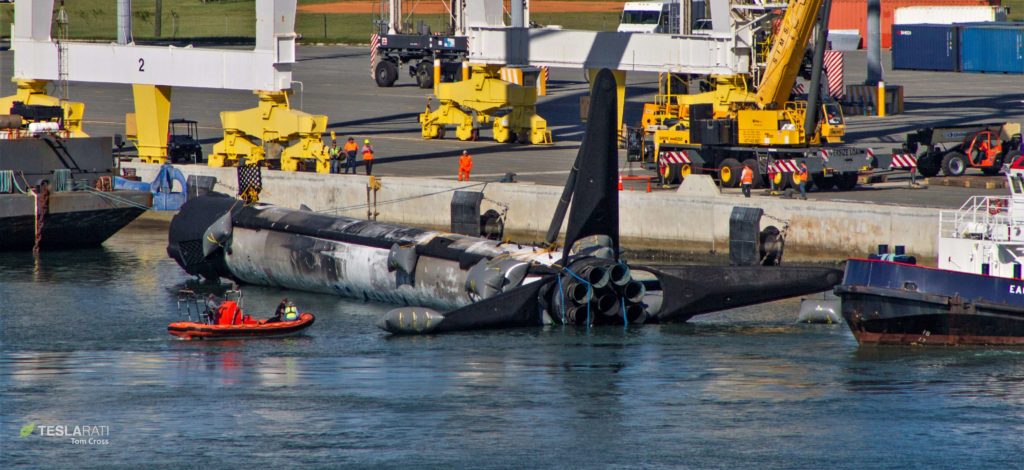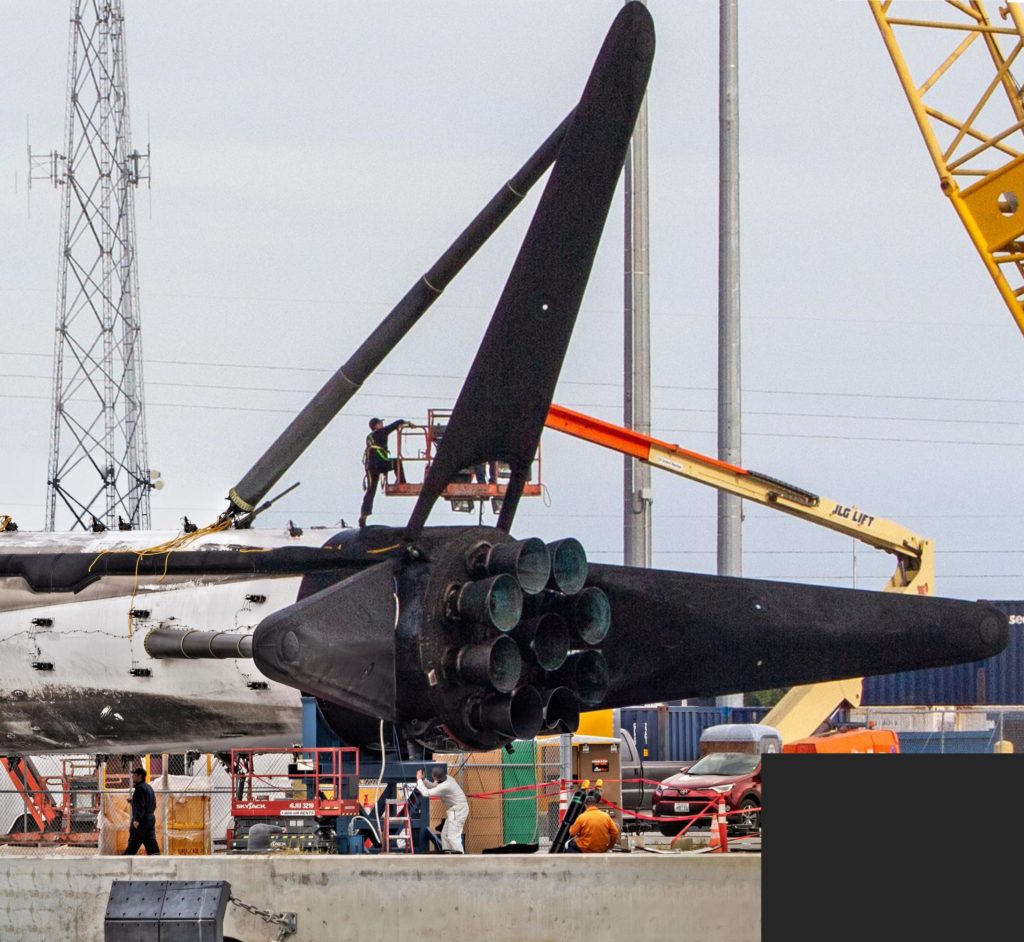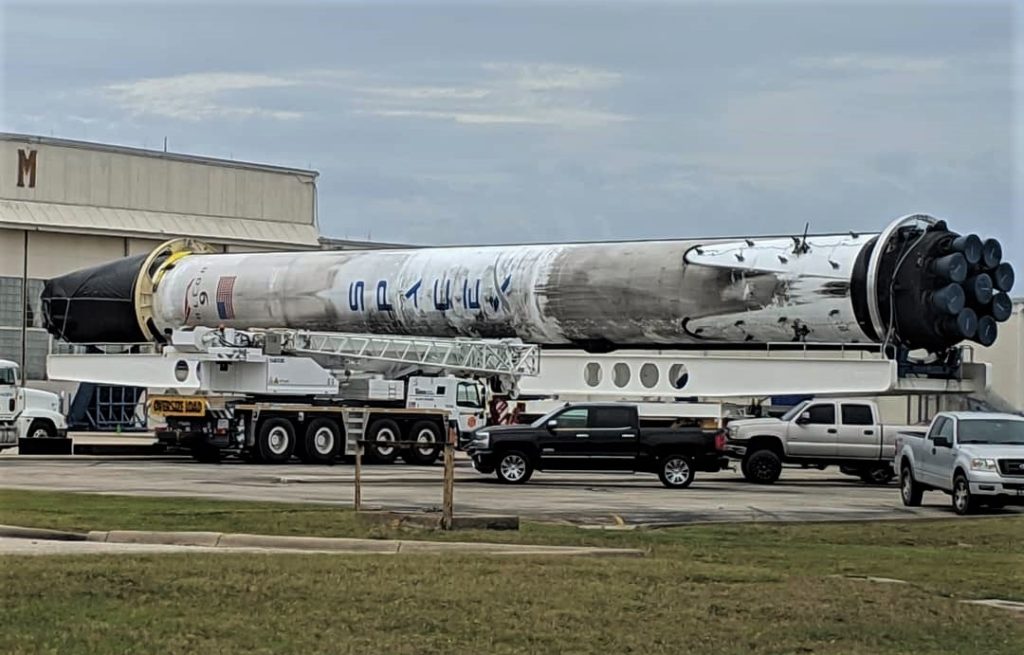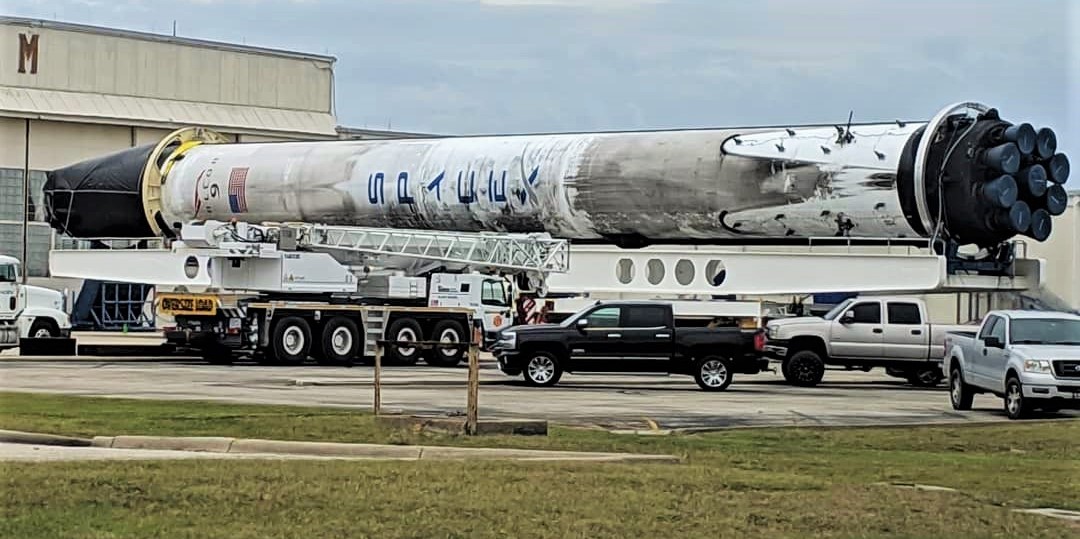
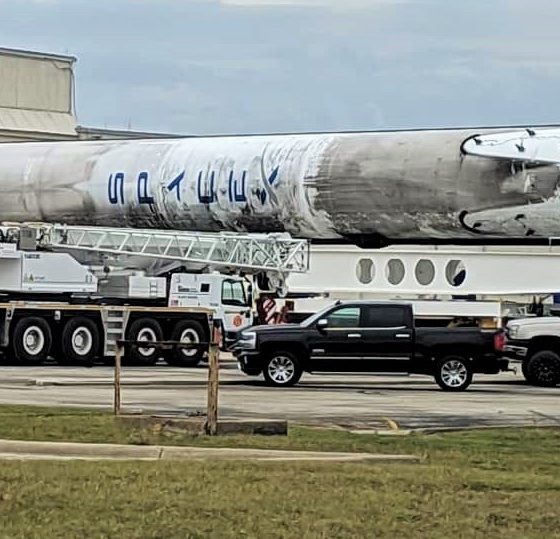
News
SpaceX lifts soggy Falcon 9 Block 5 booster ashore after accidental splashdown
Independent group USLaunchReport has published a video capturing the entirety of SpaceX’s ad hoc East Coast Falcon 9 recovery operations, in which forlorn booster B1050 had to be carefully extracted out of the ocean after an unintentional soft-landing in the Atlantic following its successful Dec. 5 launch debut.
72 hours after B1050’s water landing and some painstaking preparation, the booster was towed to SpaceX’s dock space in Port Canaveral, where it spent just a brief few hours floating adjacent to drone ship Of Course I Still Love You and the rest of the company’s Florida fleet. Considerably less than twelve hours after arriving, technicians had already managed to lift the rocket out of the ocean and onto dry land, where another week or so was spent preparing Falcon 9 for transport.
Given the extent of the damage to the Block 5 booster’s interstage and the basic fact that SpaceX recovery technicians and engineers had never attempted anything quite like it before, it was fairly impressive that they took barely six hours to lift the booster out of the water, particularly considering that the rocket appeared to be filled with hundreds or even thousands of gallons of water. No visible damage was caused, although there was clearly some cause for extensive discussion and preparation per an unusually large and lengthy huddle of more than 30 employees prior to the beginning of the lift.
https://twitter.com/_TomCross_/status/1071886823721447424
Once on land, B1050 had an unusual sling placed exactly where the Falcon 9 booster’s liquid oxygen (LOx) and kerosene (RP-1) propellant tanks were welded together, apparently a location that is particularly sensitive to off-nominal X-axis stress. To give context, imagine bending a cardboard tube or straw in half instead of trying to push its ends together – Falcon 9’s structure is quite similar in concept. Built primarily 5mm-thick sheets of lithium-aluminum alloy, Falcon 9’s propellant tanks are extremely thin and light while also being aggressively optimized for vertical (up and down) loading, i.e. the forces experienced while accelerating (and eventually decelerating) through the atmosphere during launch and landing.
As a result, SpaceX almost always pressurizes the first stage propellant tanks of Falcon 9 with nitrogen whenever boosters are horizontal without physical support at their bendy centers. In the case of B1050, SpaceX almost certainly concluded that using its waterlogged umbilical ports to inject nitrogen into its tanks was too much of a risk without knowing the precise condition of the piping and the tanks themselves, opting instead to go with a simple sling to prevent damage from unintended bending. Thankfully, B1050 appears to have made it through its dry land ordeal even better than the time it spent in the Atlantic, suffering no visible damage whatsoever.
- Sad interstage is sad. (Tom Cross)
- An almost impossibly rare view. (Tom Cross)
- That’s no boat… (Teslarati)
- SpaceX technicians had to go through the normal process of Falcon 9 booster recovery at a decidedly abnormal 90 degree delta. (Tom Cross)
- Falcon 9 B1050 was spotted at CCAFS near hangars SpaceX leases for refurbishment. (Instagram/anonymous)
Somewhere between December 14 and 15, the booster was at long last lifted onto SpaceX’s primary East Coast booster transporter and carefully drove the rocket to one of its 2-3 Cape Canaveral Air Force Station (CCAFS) refurbishment and storage hangars, avoiding detection by all but a few passersby. This could full well be the last we see (and even hear) of poor old Falcon 9 B1050, but there is still a decent chance that SpaceX hopes the entire rocket or major components can be easily salvaged.
Given the extreme care taken during the booster’s lift onto land and the week it spent having legs and grid fins removed, it can be definitively concluded that an effort will be made to save the entire vehicle (sans interstage). If it has managed to make it through the past two weeks largely unscathed, it may well become the first Falcon 9 to conduct a dedicated launch of multiple Starlink satellites sometime in the second half of 2019, at least according to CEO Elon Musk’s vague suggestion that it could fly on an “internal SpaceX mission”.
We may use it for an internal SpaceX mission
— Elon Musk (@elonmusk) December 5, 2018
For prompt updates, on-the-ground perspectives, and unique glimpses of SpaceX’s rocket recovery fleet check out our brand new LaunchPad and LandingZone newsletters!

News
Tesla Model Y Standard stuns in new range test, besting its Premium siblings
Tesla’s newer vehicles have continued to meet or exceed their EPA estimates. This is a drastic change, as every 2018-2023 model year Tesla that Edmunds assessed did not meet its range estimates.
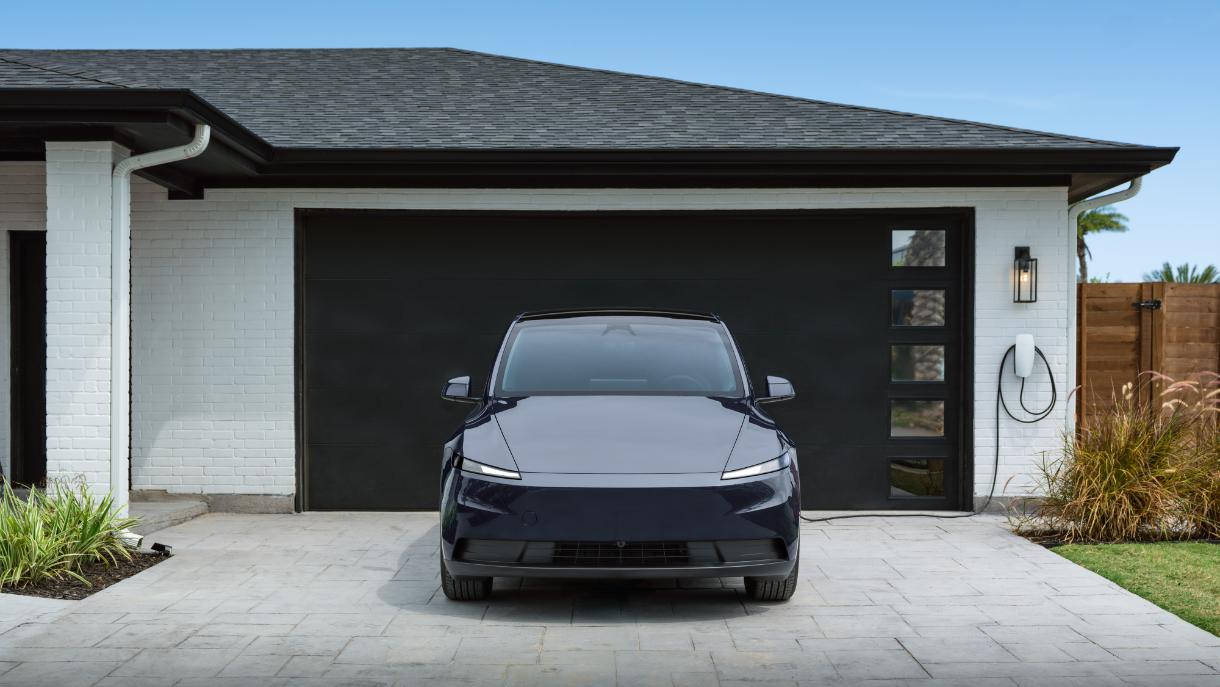
The Tesla Model Y Standard stunned in a new range test performed by automotive media outlet Edmunds, besting all of its Premium siblings that are more expensive and more luxurious in terms of features.
Testing showed the Model Y Standard exceeded its EPA-estimated range rating of 321 miles, as Edmunds said it is the “longest-range Model Y that we’ve ever put on our loop.” In the past, some vehicles have come up short in comparison with EPA ranges; for example, the Model Y’s previous generation vehicle had an EPA-estimated range of 330 miles, but only drove 310.
Additionally, the Launch Series Model Y, the first configuration to be built in the “Juniper” program, landed perfectly on the EPA’s range estimates at 327 miles.
It was also more efficient than Premium offerings, as it utilized just 22.8 kWh to go 100 miles. The Launch Series used 26.8 kWh to travel the same distance.
It is tested using Edmunds’ traditional EV range testing procedure, which follows a strict route of 60 percent city and 40 percent highway driving. The average speed throughout the trip is 40 MPH, and the car is required to stay within 5 MPH of all posted speed limits.
Each car is also put in its most efficient drive setting, and the climate is kept on auto at 72 degrees.
“All of this most accurately represents the real-world driving that owners do day to day,” the publication says.
With this procedure, testing is as consistent as it can get. Of course, there are other factors, like temperature and traffic density. However, one thing is important to note: Tesla’s newer vehicles have continued to meet or exceed their EPA estimates. This is a drastic change, as every 2018-2023 model year Tesla that Edmunds assessed did not meet its range estimates.
Tesla Model Y Standard vs. Tesla Model Y Premium
Tesla’s two Model Y levels both offer a great option for whichever fits your budget. However, when you sit in both cars, you will notice distinct differences between them.
The Premium definitely has a more luxurious feel, while the Standard is stripped of many of the more premium features, like Vegan Leather Interior, acoustic-lined glass, and a better sound system.
You can read our full review of the Model Y Standard below:
Tesla Model Y Standard Full Review: Is it worth the lower price?
News
Xpeng CEO: Tesla FSD 14.2 has developed “near-Level 4” performance
While acknowledging that imperfections remain, the Xpeng CEO said FSD’s current iteration significantly surpasses last year’s capabilities.

Xpeng CEO He Xiaopeng has offered fresh praise for Tesla’s Full Self-Driving (FSD) system after revisiting Silicon Valley more than a year after his first hands-on experience.
Following extended test drives of Tesla vehicles running the latest FSD software, He stated that the system has made major strides, reinforcing his view that Tesla’s approach to autonomy is indeed the proper path towards autonomy.
Tesla FSD closing in on Level 4 driving
During his visit, He test-drove a Tesla equipped with FSD V14.2. He also rode in a Tesla Robotaxi. Over roughly five hours of driving across Silicon Valley and San Francisco, He said both vehicles delivered consistent and reassuring performance, a notable improvement from his experience a year earlier.
According to He, Tesla’s FSD has evolved from a smooth Level 2 advanced driver assistance system into what he described as a “near-Level 4” experience in terms of capabilities. While acknowledging that imperfections remain, the Xpeng CEO said FSD’s current iteration significantly surpasses last year’s capabilities. He also reiterated his belief that Tesla’s strategy of using the same autonomous software and hardware architecture across private vehicles and robotaxis is the right long-term approach, allowing users to bypass intermediate autonomy stages and move closer to Level 4 functionality.
He previously tested Tesla’s FSD V12.3.6 and Waymo vehicles in California in mid-2024, noting at the time that Waymo performed better in dense urban environments like San Francisco, while Tesla excelled in Silicon Valley and on highways.
Xpeng’s ambitious autonomy roadmap and internal challenge
The Silicon Valley visit also served as a benchmark for Xpeng’s own autonomy ambitions. He stated that Xpeng is looking to improve its VLA autonomous driving system to match the performance of Tesla’s FSD V14.2 within China by August 30, 2026. Xpeng is poised to release its VLA 2.0 smart driving software next quarter, though He cautioned that the initial version will not be able to match FSD V14.2’s capabilities, as noted in a CNEV Post report.
He also added a personal twist to the goal, publicly challenging Xpeng’s autonomous driving team. If the performance target is met by the 2026 deadline, the CEO stated that he will approve the creation of a Chinese-style cafeteria for Xpeng’s Silicon Valley team. If not, Liu Xianming, head of Xpeng’s autonomous driving unit, has pledged to run naked across the Golden Gate Bridge, He noted.
News
Another Tesla Model 3 variant sold out for January 2026 in China
A look at Tesla China’s order page shows that new Model 3 LR RWD orders now have an estimated delivery date of February 2026.
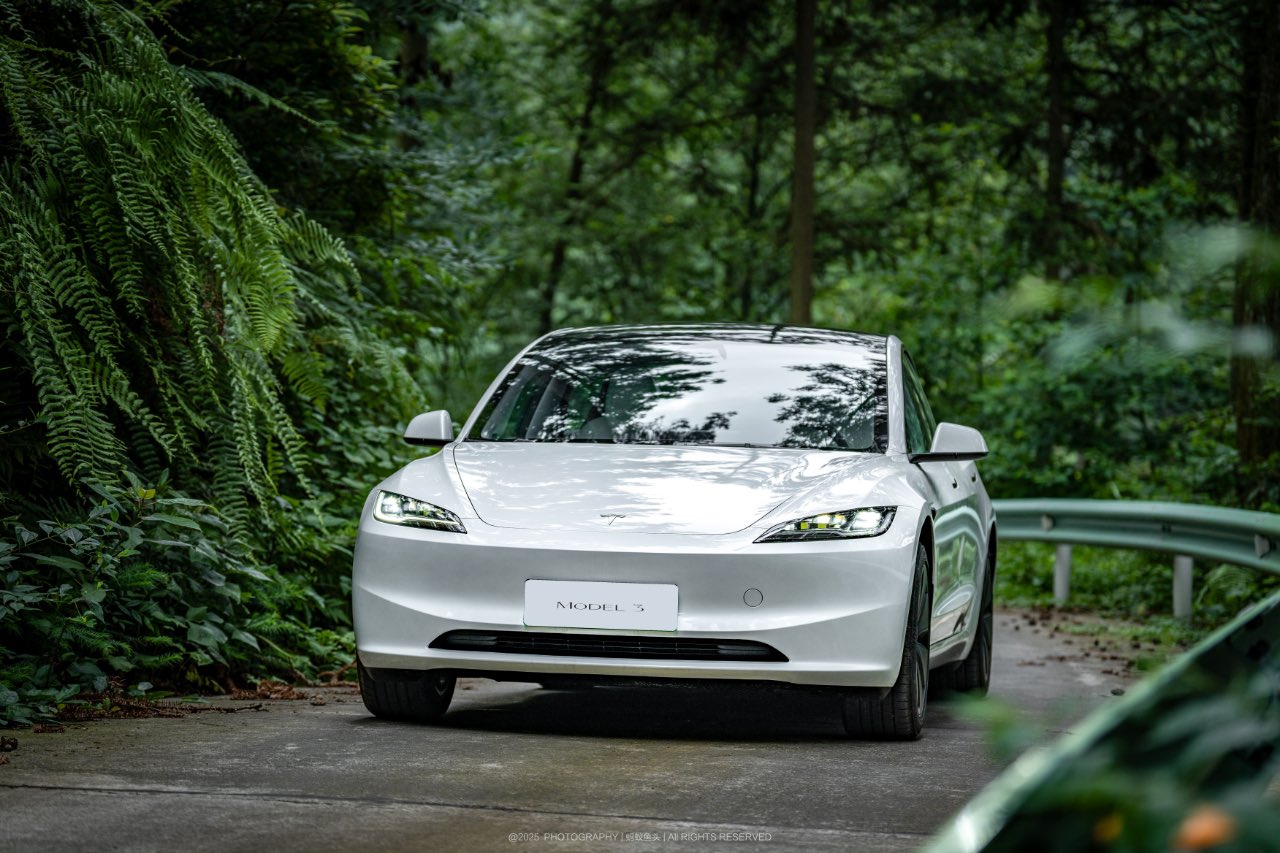
Another Tesla Model 3 variant in China appears to have sold out for January 2026, with the vehicle now showing an estimated delivery date of February 2026 for new orders. This bodes well for the all-electric sedan, which has maintained notable sales despite more affordable rivals like the Xiaomi SU7 and its crossover sibling, the Model Y.
Model 3 LR RWD joins February 2026 queue
A look at Tesla China’s order page for the all-electric sedan shows that new Model 3 Long Range Rear Wheel Drive orders now have an estimated delivery date of February 2026. Priced from RMB 259,500 ($36,810), the LR RWD sits as the second-lowest-priced trim in Tesla China’s four-variant Model 3 lineup. The move follows a similar delivery timeframe for the Model 3 Performance, which remains the most expensive option for the vehicle, as noted in a CNEV Post report.
The estimated delivery dates of the two remaining Model 3 variants remain unchanged for now. The base RWD version, starting at RMB 235,500, and the LR AWD variant, priced from RMB 285,500, both continue to list estimated delivery times of 4-6 weeks. Tesla China, for its part, has continued to list in-stock Model 3 vehicles and is actively encouraging buyers to select inventory units for delivery before the end of the year.
Model Y delays and policy shifts
Delivery timelines for the Model Y in China are also stretching into 2026. All customized Model Y variants now show February 2026 as their estimated delivery date, except for the entry-level version, which still lists January 2026. Tesla has been urging customers since November to prioritize purchasing inventory vehicles, a push aimed at maximizing year-end deliveries.
Timing matters for Chinese buyers due to upcoming changes in government incentives. China’s new energy vehicle purchase tax exemption will be scaled back in 2026, which means customers who take delivery next year could face higher tax costs compared to those who are able to receive vehicles before the end of the year.
As per data from the China Passenger Car Association, Tesla recorded retail sales of 73,145 vehicles in November, down 0.47% year over year. From January through November, Tesla’s retail sales in China totaled 531,855 units, a 7.37% year-over-year drop.
